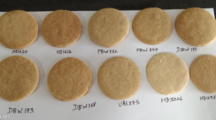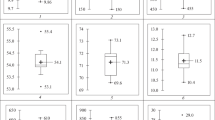Abstract
The aim of the present study was to determine the suitability of different wheat cultivars in terms of dough sheeting behaviour and final product quality in baklava production using correlation and Principal Component Analyses (PCA). For this purpose, 18 wheat cultivars were used. While thousand-kernel weight, hectolitre weight, and hardness index of the wheats were in the range of 30.2–49.6 g, 71.3–79.9 kg/hl, and 10.8–84.8%; protein and ash content, Zeleny sedimentation, wet and dry gluten, gluten index, and b* color values of flours were in the range of 11.25–18.10%, 0.55–0.90%, 16.8–65.0 ml, 23.6–46.2%, 8.2–16.0%, 2.7–100.0%, and 7.3–14.4, respectively. Thickness (T) and surface area (SA) of sheeted doughs after first sheeting (T-1, SA-1) and second sheeting (T-2, SA-2) were in the range of 0.310–0.500 mm, 2.77–3.63 m2, 0.084–0.133 mm, and 19.68–36.96 m2, while hardness, peak counts, and linear distance of baklava samples were in the range of 747–1341 g, 40–59, and 2757–4638 (g.s), respectively. There were significant correlations between SA-2 and Zeleny sedimentation and Alveograph W, protein, and wet and dry gluten contents (p < 0.01). There were also significant correlations between peak counts and SDS, modified SDS (p < 0.01), protein content, Zeleny sedimentation, and Alveograph W and Mixolab C1 values (p < 0.05).

Similar content being viewed by others
References
Bertozzi L (1998) Tipicidad alimentaria y dieta mediterra´nea. In: Medina A, Medina F, Colesanti G (eds) El color de la alimentacio´n mediterra´nea. Elementos sensoriales y culturales de la nutricio´n. Icaria, Barcelona, pp 15–41
Jordana J (2000) Traditional foods: challenges facing the European food industry. Food Res Int 33:147–152
Guerrero L, Gua`rdia MD, Xicola J, Verbeke W, Vanhonacker F, Zakowska-Biemans S et al (2009) Consumer-driven definition of traditional food products and innovation in traditional foods. A qualitative cross-cultural study. Appetite 52:345–354
Biringen Löker G, Amoutzopoulos B, Özge Özkoç S, Özer H, Şatir G, Bakan A (2013) A pilot study on food composition of five Turkish traditional foods. Br Food J 115(3):394–408
Costa HS, Vasilopoulou E, Trichopoulou A, Finglas P (2010) New nutritional data on traditional foods for European food composition databases. Eur J Clin Nutr 64:73–81
Trichopoulou A, Vasilopoulou E, Georga K, Soukara S, Dilis V (2006) Traditional foods: why and how to sustain them. Trends Food Sci Technol 17:498–504
EU (European Union) (2013) Commission Implementing Regulation (EU), No 1399/2013. Brussels. pp. 1
Köz P, Boyacıoğlu D, Özçelik B (2004) Development of a functional Turkish desert: Dietetic and diabetic baklava. 2004 IFT Annual Meeting, July 12–16, Las Vegas, USA
TLA (Turkish Language Association) (2022) Baklava. Turkish Language Association, Turkish Dictionary. https://sozluk.gov.tr/ (in Turkish)
Akkaya A, Koc B (2017) Past, present and tomorrow of Baklava. Int Rural Tour Dev (IRTAD) J 1:47–50
Işın PM (2013) Sherbet & spice: the complete story of Turkish sweets and desserts. Tauris & Co Ltd., London, England
Perry C (1994) The taste for layered bread among the nomadic Turks and the Central Asian Origins of Baklava. In: Zubaida S, Tapper R (eds) A taste of thyme: culinary cultures of the middle east. Tauris & Co Ltd., London
Işın PM (2015) The Oxford companion to sugar and sweets. Edited by D Goldstein. Oxford University Press, USA
Perry C (1988) Baklavanın Orta Asya Kökenleri. (Central Asian origins of baklava). II. Milletlerarası Yemek Kongresi. Konya Kültür ve Turizm Vakfı, Ankara, pp 356–363
TPI (Turkish Patent Institute) (2007) Antep Baklava, Geographical Registration Certificate, Registration No: 95, Application No: C2005/005, pp. 2
Acar O, Koksel H (2023) A study on the estimation of dough sheeting behaviour and textural properties of baklava from commercial flour properties. J Cereal Sci 110:103647
Akyıldız E (2010) Geleneksel Türk Tatlısı ‘Baklava’. The 1st International Symposium on Traditional Foods from Adriatic to Caucasus, April, 15–17, Tekirdağ, Türkiye. pp. 106–108
Yeyinli Savlak N, Köse E (2014) Physical, Physicochemical and rheological properties of baklava flours produced in Türkiye. Türk Tarım ve Doğa Bilimleri Dergisi 1:219–226
AACC International (2010) The AACC approved methods of analysis, 11th edn. The Association, St. Paul
ISO 520 (2010) Cereals and Pulses-Determination of the Mass of 1000 Grains
Vasiljevic S, Banasik OJ (1980) Quality testing methods for durum wheat and its products. Department of Cereal Chemistry and Technology, North Dakota State University Fargo, North Dakota
ASTM (American Society for Testing and Materials) (2002) Standard practice for obtaining spectrophotometric data for object-color evaluation, Method No: E 1164
Williams P, El-Haramein FJ, Nakkoul H, Rihavi S (1988) Crop quality evaluation methods and guidelines. International Center for Agricultural Research in the Dry Areas, ICARDA, Aleppo, Syria, 145p
ICC (2008) ICC Standard Methods. International Association for Cereal Science and Technology (ICC), Vienna, Austria: The Association
Acar O, Sanal T, Köksel H (2019) Effects of wheat kernel size on hardness and various quality characteristics. Qual Assur Saf Crops Foods 11(5):459–464
Koten M, Atlı A, Ünsal AS (2008) Some Quality Characteristics of Flours Used for Baklava. ICC International Conference Bosphorus 2008, İstanbul, Türkiye. pp 118
Acknowledgements
The authors would like to express their sincere gratitude to Çağır Bakery Products Co. for providing the raw materials and their support in baklava production.
Author information
Authors and Affiliations
Corresponding author
Ethics declarations
Conflict of interest
The authors declare that they have no conflict of interest.
Compliance with ethics requirements
This article does not contain any studies with human or animal subjects.
Additional information
Publisher's Note
Springer Nature remains neutral with regard to jurisdictional claims in published maps and institutional affiliations.
Rights and permissions
Springer Nature or its licensor (e.g. a society or other partner) holds exclusive rights to this article under a publishing agreement with the author(s) or other rightsholder(s); author self-archiving of the accepted manuscript version of this article is solely governed by the terms of such publishing agreement and applicable law.
About this article
Cite this article
Acar, O., Koksel, H. Determination of the suitability of wheat cultivars for baklava production. Eur Food Res Technol 249, 3141–3150 (2023). https://doi.org/10.1007/s00217-023-04355-1
Received:
Revised:
Accepted:
Published:
Issue Date:
DOI: https://doi.org/10.1007/s00217-023-04355-1




